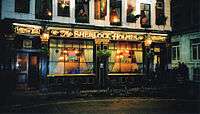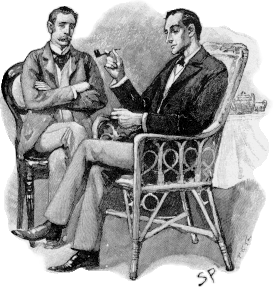221B Baker Street
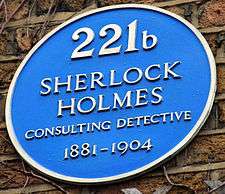
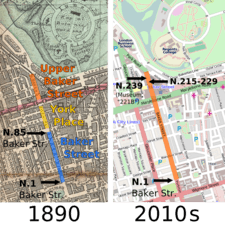
221B Baker Street is the London address of the fictional detective Sherlock Holmes, created by author Sir Arthur Conan Doyle. In the United Kingdom, postal addresses with a number followed by a letter may indicate a separate address within a larger, often residential building. Baker Street in Holmes' time was a high-class residential district, and Holmes' apartment was probably part of a Georgian terrace.
At the time the Holmes stories were published, addresses in Baker Street did not go as high as 221. Baker Street was later extended, and in 1932 the Abbey National Building Society moved into premises at 219–229 Baker Street. For many years, Abbey National employed a full-time secretary to answer mail addressed to Sherlock Holmes. In 1990, a blue plaque signifying 221B Baker Street was installed at the Sherlock Holmes Museum, situated elsewhere on the same block, and there followed a 15-year dispute between Abbey National and the Holmes Museum for the right to receive mail addressed to 221B Baker Street. Since the closure of Abbey House in 2005, ownership of the address by the Holmes Museum has not been challenged, despite its location between 237 and 241 Baker Street.
Conan Doyle's intentions
We met next day as he had arranged, and inspected the rooms at No. 221B, Baker Street, of which he had spoken at our meeting. They consisted of a couple of comfortable bed-rooms and a single large airy sitting-room, cheerfully furnished, and illuminated by two broad windows.
(Arthur Conan Doyle, A Study in Scarlet, 1887)
When the "Sherlock Holmes" stories were first published, street numbers in Baker Street did not go as high as 221, which was presumably why Conan Doyle chose a higher street number for the location of his hero, to prevent any person's actual residence from being affected.
The section north of Marylebone Road near Regent's Park – now including 221 Baker Street – was known in Conan Doyle's lifetime as Upper Baker Street. In his first manuscript, Conan Doyle put Holmes' house in Upper Baker Street, indicating that if he had a house in mind, it would have been there. However, a British crime novelist named Nigel Morland claimed that, late in Conan Doyle's life, he identified the junction of Baker Street and George Street, about 500 metres south of the Marylebone Road, as the location of 221B. Sherlockian experts have also held to alternative theories as to where the original 221B was located and have maintained that it was further down Baker Street.[1]
Real 221B Baker Street addresses
Abbey National
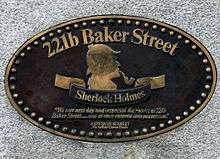
When street numbers were reallocated in the 1930s, the block of odd numbers from 215 to 229 was assigned to an Art Deco building known as Abbey House, constructed in 1932 for the Abbey Road Building Society, which the society and its successor (which subsequently became Abbey National plc) occupied until 2002.
Almost immediately, the building society started receiving correspondence from Sherlock Holmes fans all over the world, in such volumes that it appointed a permanent "secretary to Sherlock Holmes" to deal with it. A bronze plaque on the front of Abbey House carried a picture of Holmes and a quotation, but was removed from the building several years ago. Its present whereabouts are unknown. In 1999, Abbey National sponsored the creation of a bronze statue of Sherlock Holmes that now stands at the entrance to Baker Street tube station.
Sherlock Holmes Museum
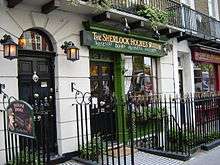
The Sherlock Holmes Museum is situated within an 1815 townhouse very similar to the 221B described in the stories and is located between 237 and 241 Baker Street. It displays exhibits in period rooms, wax figures and Holmes memorabilia, with the famous study overlooking Baker Street the highlight of the museum. The description of the house can be found throughout the stories, including the 17 steps leading from the ground-floor hallway to the first-floor study.[2]
According to the published stories, "221B Baker Street" was a suite of rooms on the first floor of a lodging house above a flight of 17 steps.[2] The main study overlooked Baker Street, and Holmes' bedroom was adjacent to this room at the rear of the house, with Dr. Watson's bedroom being on the floor above, overlooking a rear yard that had a plane tree in it.[3][4]
Address controversy
The street number 221B was assigned to the Sherlock Holmes Museum on 27 March 1990 (replacing the logical address 239 Baker Street) when the Leader of Westminster City Council, Lady Shirley Porter, unveiled a blue plaque signifying the address of 221B Baker Street. She was invited to renumber the museum's building to coincide with its official opening (and because the number 221B had not been included in the original planning consent for the museum granted in October 1989).
A long-running dispute over the number arose between the Sherlock Holmes Museum, the building society Abbey National (which had previously answered the mail addressed to Sherlock Holmes) and subsequently the local Westminster City Council. The main objection to the Museum's role in answering the letters was that the number 221B bestowed on the Museum by the Council was out of sequence with the other numbers in the street: an issue that has since vexed local bureaucrats, who have striven for years to keep street numbers in sequence. In 2005, Abbey National vacated their headquarters in Baker Street, which left the museum to battle with Westminster City Council to end the dispute over the number, which had created negative publicity.
After the closure of Abbey House in 2005, the Royal Mail recognised the museum's exclusive right to receive mail addressed to Sherlock Holmes.
Sherlock Holmes Pub
Another version of Sherlock Holmes' apartment is at the Sherlock Holmes pub in Northumberland Street near Charing Cross railway station. This was originally a small hotel, the Northumberland Arms, but was refurbished and reopened under its present name in December 1957. Its owners, Whitbread & Co, were fortunate to own the entire Sherlock Holmes exhibit put together by Marylebone Borough Library and the Abbey National for the 1951 Festival of Britain. The pub was restored to a late Victorian form and the exhibit, a detailed replica of Holmes' fictional apartment, was installed on the upstairs floor.
In the United States, there is a pub/restaurant chain named "Baker Street Pub," that plays off of the Sherlock Holmes theme.[5] Some locations even have the iconic British red phone booth outside.[6]
In other media
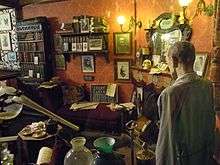
The fictional address has been portrayed in the following pastiches of Sherlock Holmes:
- Basil of Baker Street resides in 221½ Baker Street, a mouse-hole beneath 221B Baker Street.
- Private detective Louie Knight moves into an office at 22/1B Stryd-y-Popty (which translates as Baker Street in Welsh) in Malcolm Pryce's Welsh Noir parody The Unbearable Lightness of Being in Aberystwyth, ISBN 978-0-7475-7894-9.
- The 1987 CBS movie The Return of Sherlock Holmes (not to be confused with the 1986 British television series of the same name) features Holmes, cryogenically frozen in 1899 and awakened in modern times, trying to adapt with the aid of Watson's granddaughter, Jane. He seeks out his old residence and finds the spot occupied by a McDonald's franchise.
- Dr. Gregory House, the protagonist of House, M.D., lives at 221 Baker Street, Apartment B, Princeton, NJ, 08542, as shown on the character's driver license seen in season seven's thirteenth episode, "Two Stories", first aired 21 February 2011. This address previously appears on the $5,000 check he writes (and eventually slides through the mail slot) to Lorenzo Wibberly in Season 6, Episode 11: "Remorse." The address also appears in a letter approving citizenship of Dominika House in season 8, Episode 17: "We need the eggs". The first appearance of the address was in Season 2, Episode 7: "Hunting". Dr. House and Dr. Wilson leave House's apartment and in the background a sign saying "221B" can be seen. A building sign reading "221" can been seen at the end of season three's last episode, "Human Error", as House enters his apartment building.
- Danger Mouse, in the cartoon show of the same name, is said to live in a pillar box near 221b Baker Street. However, Danger Mouse is a loose parody of Danger Man and James Bond, rather than Sherlock Holmes. The pillar box is a stone's throw away from 221B Baker Street and Dr. Watson throws stones at them in apparent jealousy that he only works for the world's greatest detective, not the world's greatest secret agent in the episode "Where There's a Well, There's a Way".
- In the animated Justice League series, in episode 21 of Season 2, Green Lantern passes by a building with 221B Baker Street emblazoned across the top in an obvious reference to Holmes.
- In the Phryne Fisher series by Kerry Greenwood, the detective Hon. Phryne Fisher resides at 221 The Esplanade, St Kilda (Melbourne, Australia), which she renumbers to 221B in homage to Holmes.
- In Star Trek: The Next Generation, Data tells another crew member that Geordi LaForge can be found at 221b Baker St, episode 29 "Elementary, Dear Data", and 221b Baker St. is again referenced in episode 137 "Ship in a Bottle".
- In the MMORPG Wizard101, a detective named Sherlock Bones lives in an apartment at 221B Barker Street in Marleybone, a spoof of 19th century London populated by anthropomorphic dogs.
- In Season 2, Episode 1 of Elementary, Sherlock Holmes and Joan Watson visit London and stay in a second floor residence numbered 221B. Sherlock indicates he had happily resided there before his move to New York City.
- In the Baker Street Letters (ISBN 9780312538125) (and sequels) two barrister brothers rent chambers at 220 Baker street (the Dorset House) and the landlord requires as part of the lease that they respond to letters addressed to Sherlock Holmes at 221B Baker St. The landlord is "Dorset House Housing Trust".
- In the 2015 film Mr. Holmes, a long-retired Holmes (Ian McKellen) remarks that the Baker Street address is one of several fictitious details created by Watson, who wrote the cases up as sensationalist stories for publication. In a flashback, as curious onlookers gather outside 221B, Holmes watches from a window of his actual residence nearby and congratulates a client for finding the right address.
- In the first episode of the third season of Breaking Bad, it is seen that the number of Walter White's temporary residence is 221.
- The BBC Television series Sherlock has used 187 North Gower Street to represent 221B Baker Street for shooting the exterior scenes of Sherlock Holmes' flat. The location is near Euston railway station, and roughly a mile away from the real Baker Street.
- In Dai Gyakuten Saiban: Naruhodō Ryūnosuke no Bōken, 221B Baker Street is the residence of Sherlock Holmes, who lives there along with the deceased Dr. Watson's daughter, Iris Watson. It was also where the Ryūnosuke Naruhodō and Susato Mikotoba have their legal agency.
References
- ↑ Baker Street By-Ways by James Edward Holroyd ISBN 978-1-883402-71-6
- 1 2 Conan Doyle, Arthur (1892), "A Scandal in Bohemia", The Adventures of Sherlock Holmes, ISBN 978-0-7607-1577-2 (
- 1661 at Project Gutenberg).
- ↑ Conan Doyle, Arthur (1927), "The Problem of Thor Bridge", The Case-Book of Sherlock Holmes, ISBN 978-0-7195-3012-8.
- ↑ "Sherlock Holmes 101", Washington Post, 11 January 2004
- ↑ http://bakerstreetpub.com
- ↑ http://bakerstreetpub.com/Sugar-Land/
External links
| Wikimedia Commons has media related to 221B Baker Street. |
- The United Kingdom website
- The Sherlock Holmes Museum
- The Baker Street Journal an Irregular quarterly of Sherlockiana
- 221B Baker Street Floor Plan Illustration
- 221b Blue Plaque
- 221b Baker Street, United Kingdom
Coordinates: 51°31′24″N 0°09′30″W / 51.52333°N 0.15833°W
